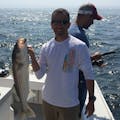The low-power, remote sensing platform provided by the Thingy:53 provides a convenient and inexpensive way to monitor a variety of different environmental factors. Plus, given its small compact size, it can be placed in places that are hard to normally access. After some brainstorming with my son, we decided it would be really cool to monitor what happens 'inside' a compost pile and use that information to make data driven decisions about how to maximize the output of a home compost pile.
WHY IS THIS IMPORTANT?The graphic below provided by the US Environmental Protection Agency provides the percentage of material entering municipal solid waste landfills. The information shows that roughly half of the material entering landfills is compostable!
- Composting makes us less dependent on landfills and decreases greenhouse gas emissions.
- Compost enhances soil and promotes healthy plant growth.
- Composting is a natural source of nutrients reducing need for synthetic fertilizers.
- Composting promotes a prolific soil ecosystem and produces soil that can be used in your yard.
- In addition to the benefits above, composting also reduces the fossil fuels needed to transport all that waste to landfill
Composting can be frustrating and messy if not done properly. Sometimes the material (leaves, food waste, etc) doesn't break down in a timely fashion or sometimes the wrong types of microorganisms invade. In my own experience, I piled a large pile of leaves and grass clippings only to have the pile take months to break down into anything resembling soil.
If we could make it easier to monitor and manage a compost pile more people would see the value--enter the Thingy:53!
GETTING STARTEDOnce you have your Thingy:53, there are a few resources I'd recommend using to learn how to use.
- Nordic Developer Academy Getting started with Thingy:53 — nRF Connect SDK 2.1.99 documentation (nordicsemi.com)
- Getting started with the Thingy:53 Getting started with Thingy:53 — nRF Connect SDK 2.1.99 documentation (nordicsemi.com)
- Nordic Dev Zone Nordic DevZone (nordicsemi.com)
- Bosch BME688 Sensor BME688 Datasheet (bosch-sensortec.com)
First, I looked in the C:\ncs\v2.1.1\zephyr\samples\bluetooth examples provided as part of the Toolchain install and found the following in the notes:
A SIMPLE STRATEGY
Leverage an existing bluetooth peripheral example and merge it with the modified BME680 C:\ncs\v2.1.1\zephyr\samples\sensor\bme680 code. Since the sensors are made by the same vendor I made the assumption that the I2C addressing would be similar so only minor modifications would be needed to leverage the sample with the Thingy:53
This requires changing the.yaml file in the example to include the Thingy:53 board (see below)
Then I added a new board file located here: C:\ncs\v2.1.1\zephyr\samples\sensor\bme680\boards
I ran out of time before I was able to layer-in the BLE peripheral sample to transmit the BME688 data to the BLE Central Node. My goal would have been to eventually include the CO2 sensor readings and use Edge Impulse to learn the relationship between Temperature and CO2 readings. This information would be used to make predictive assesments on













Comments
Please log in or sign up to comment.